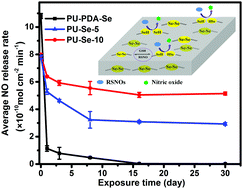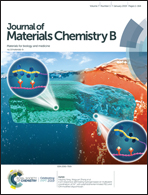Selenium-containing polyurethane with elevated catalytic stability for sustained nitric oxide release†
Abstract
Stable and controllable nitric oxide (NO) release at the physiological level from biomedical materials remains a challenge for NO-based therapy. NO-generating polymers have great potential to achieve this goal because they can catalytically decompose endogenous S-nitrosothiols (RSNOs) into NO. However, the current catalytic surfaces based on such polymers often suffer from loss of catalytic sites, which can influence the stability of NO release in their long-term application. In this work, we proposed a novel strategy to enhance the catalytic stability of NO-catalytic materials by incorporating catalytic sites into the polymer backbone. Selenium-containing polyurethane (PU-Se) was synthesized by using the catalyst 2,2′-diselenodiethanol (SeDO) as the chain extender. A series of PU/PU-Se blend films were prepared to investigate the effect of PU-Se content on the catalytic properties. The blend films exhibited excellent catalytic activity, and also showed outstanding catalytic stability in comparison with PU coated by diselenide/dopamine (PU-PDA-Se). Among these blend films, PU-Se-10 exhibited a stable NO release rate of 5.05 × 10−10 mol cm−2 min−1 after exposure to PBS buffer for 30 days. Moreover, the PU/PU-Se films exhibited decreased platelet activation/adhesion, low hemolysis ratio, excellent biocompatibility, and similar mechanical properties to PU. It is expected that the newly designed PU-Se has great potential in generating stable NO release at the physiological level for the long-term application of blood-contacting medical devices.



 Please wait while we load your content...
Please wait while we load your content...